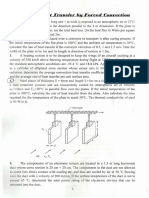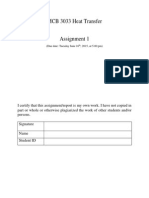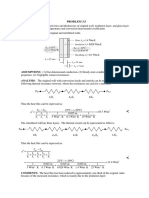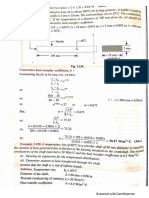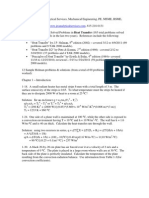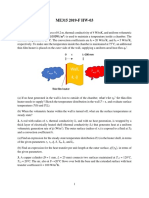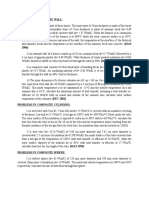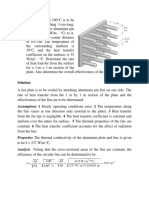0 ratings0% found this document useful (0 votes) 269 views12 pagesAssignment 1
Heat Transfer Problems Chapter 1 from Textbook
Copyright
© © All Rights Reserved
We take content rights seriously. If you suspect this is your content,
claim it here.
Available Formats
Download as PDF or read online on Scribd
3-29 A transparent film is to be bonded onto the top a
face of a solid plate inside a heated chamber. For the ra c
| cure properly, a temperature of 70°C is to be maintaine :
| the bond, between the film and the solid plate. The caneteie
film has a thickness of 1 mm and thermal conductivity ©
0.05 W/mK, while the solid plate is 13 mm thick and has a
thermal conductivity of 1.2 W/m-K. Inside the heated chan
ber, the convection heat transfer coefficient is 70 W/mK. If
the bottom surface of the solid plate is maintained at 52°C,
determine the temperature inside the heated chamber and the
surface temperature of the transparent film. Assume thermal
contact resistance is negligible.
Transparent film
Air, h= 70 Wim?-K k= 0.05 Wim-K
T, = 70°C
E P3-29
To defrost ice accumulated on the outer surface of
jutomobile windshield, warm air is blown over the inner
face of the windshield. Consider an automobile wind.
with thickness of 5 mm and thermal conductivity of
/m:K. The outside ambient temperature is — 19°C
convection heat transfer coefficient is 200 W/m?-K,
‘the ambient temperature inside the automobile ig
Determine the value of the convection heat transfer
it for the warm air blowing over the inner surface
hield necessary to cause the accumulated ice to
flux of 5:
is expose
the conv!
surround
two atta
pates thr
surface «
plate has
tact con¢
FIGUF
3-32 Ti
slab (k =
vection |
faces of t
winter nj
the night
surfaces
of 20°C.
is 0.9. ©
fers, dete
the inner
If the
an efficig
1 20/the
Mine the�le L=5mm
Outside air, -10°C :
h, = 200 W/m?-K Windshield
IEE Inside air, 25°C
new tn
An aluminum plate of 25 mm thick (k = 235 W/m-K)
is attached on a copper plate with thickness of 10 mm. The
copper plate is heated electrically to dissipate a uniform heat�flux of 5300 W/m?. The upper surface of the aluminum Plat
is exposed to convection heat transfer in a condition such thy
the convection heat transfer coefficient is 67 W/m2-K and the
surrounding room temperature . Other surfaces of the
two attached plates are insulated such that heat onl dissj-
pates through the upper surface of the aluminum plate. If the
Surface of the copper plate that is attached to the aluminum
a temperature of 100°C, determine the thermal con-
Air, 20°C
7 Wim?sK
"ee woud oe e
‘
.
*
a
f
P
|�] ae
\
' v
Heat dissipated from a machine in operation ee 1
cause hot spots on its surface. Exposed hot spots i
can cause thermal burns when in contact with human skin tis :
sue and are considered to be hazards at the workplace. :
Consider a machine surface that is made of a 5-mm thick alu- :
inum with a thermal conductivity of 237 W/m-K. During :
eration the machine dissipates about 300 W/m? of heat to the
‘oundings, and the inner aluminum surface is at 150°C. To
event machine operators from thermal burns, the machine V
face can be covered with insulation. The aluminum/ u
Sulation interface has a thermal contact conductance of
100 W/m?-K. What is the thickness required for the insulation
with a thermal conductivity of 0.06 W/m-K in order to
in the surface temperature at 45°C or lower?
m3 a0o
Insulation
Aluminum machine surface
k= 237 Wim-K�n > ve
A 4-m-high and 6-m-wide wall consists of a long 18-cm
X 30-cm cross section of horizontal bricks (k = 0.72 W/m-K)
ated by 3-cm-thick plaster layers (k = 0.22 W/m K). There
Also 2-cm-thick plaster layers on each side of the wall, and
-thick rigid foam (k = 0.026 W/m:K) on the inner sid
wall. The indoor and the outdoor temperatures are
P=4°C, and the convection heat transfer coefficients on
and the outer sides are h, = 10 W/m?-K and h, = 2
1K, respectively. Assuming one-dimensional heat transfe
land disregarding radiation, determine the rate of heat transfer
Through the wall.�r— 18cm <>
apart,
la�3-69 Consider a 5-m-high, 8-m-long, and 0.22-m-thick wall
whose representative cross section is as given in the figure. The
thermal conductivities of various materials used, in W/m-K, are
ete =e, kp = 8, kc = 20, kp = 15, and k, 35. The
left and right surfaces of the wall are maintained at uniform
t ¢ of 300°C and 100°C, respectively. Assuming heat
ugh the wall to be one-dimensional, determine
heat transfer through the wall; (b) the temper-
point where the sections B, D, and E meet; and
rature drop across the section F. Disregard any
ances at the interfaces.
100°C
convection h
of very low
hed on the
bd�10m
FIGURE
Steam
| (k=
5.1 Wim
and 10 cm, res
is insulated wi
2-m-high electric hot-w
bled heatcehn Wim-°C), If t
ee eater that has Si
and maintains the hot water at 55 ch
: C. The determine the
small room whose Average temperature is of the pipe. \
transfer coefficients on t]
the inner and outer mal resistance
er are 50 and 12 W/m-K, respectively. The
: Hot wa
other 46-cm-diameter sheet Metal tank of through a 15
ss, and the space between the two tanks is whose inner ¢
sulation (k = 0.03 W/m-K). The thermal
tively. The o
ater tank and the outer thin sheet metal shell jg exposed to
transfer coef
cient at the i
the walls of t
of heat loss
velocity of t
drops by 3°
Ina
Wim-K) wi
2.5 mm is t
The liquid «
om ture of —2(
ie 120 W/m"
ent air temy�ameter
npera- 3-123 Steam in a heating system flows through tubes wo.
mK. outer diameter is 5 em and whose walls are maintained «
12°C, temperature of 180°C. Circular aluminum alloy 2024 16 |
arding (k = 186 W/m-K) of outer diameter 6 em and constant
ure of ness | mm are attached . The space between th
flange is 3 mm, and thus there are 250 fins per meter Ic of
ciency tube. Heat is transferred to the surrounding air at 7 Wr)
length with a heat transfer coefficient of 40 W/mK. Deternine +
ansfer increase in heat transfer from the tube per meter of its length a
a result of adding fins. Answer: 2636 W
2.5 cm
3m
Tx = 25°C
180°C
18-cm-long circuit�224 si
STEADY HEAT CONDUCTION
dissipating 0.04 W. The board is impregnated a Se K
ings and has an effective thermal conductivity of - ee
All the heat generated in the chips is conducted across | aa
cuit board and is dissipated from the back side of the board ae
medium at 40°C, with a heat transfer coefficient of 40 W /m %
(a) Determine the temperatures on the two sides of the
cuit board. (b) Now a 0.2-cm-thick, 12-cm-high, and 18-cm-
long aluminum plate (k = 237 W/m-K) with 864 2-cm-long
aluminum pin fins of diameter 0.25 cm is attached to the back
side of the circuit board with a 0.02-cm-thick epoxy adhesive
(k = 1.8 W/m-K). Determine the new temperatures on the two
sides of the circuit board.
3-125 A hot surface at 100°C is to be cooled by attaching
3-cm-long, 0.25-cm-diameter aluminum pin fins (k = 237
W/m-K) to it, with a center-to-center distance of 0.6 cm. The
temperature of the surrounding medium is 30°C, and the heat
transfer coefficient on the surfaces is 35 W/m2.K, Determine
the rate of heat transfer from the surface for a 1-m X 1-m sec-
tion of the plate. Also determine the overall effectiveness of
the fins.
r fill-�it
Bear aw
100 fins per m? surface area.
Steam in a heating system flows through tubes whose
outer diameter is 3 cm and whose walls are maintained at
temperature of 120°C. Circular aluminum alloy fins (k 180
W/m-K) of outer diameter 6 cm and constant thickness 7 = 2 mm
are attached to the tube, as shown in Fig. P3-183. The space
between the fins is 3 mm, and thus there are 200 fins per me-
ter length of the tube. Heat is transferred to the surround
ing air at 25°C, with a combined heat transfer coefficient of
60 W/m2-K. Determine the increase in heat transfer from the
tube per meter of its length as a result of adding fins.
ry=3.em r= 15cm
T,
h
Ty
Cnae
[s-amm
\ FIGURE P3-18 3.
sins ‘02a thick, er _and 15-cm-long circuit
is on one side that dissipate�STEADY HEAT CONDUCTION and
: ~m-long:
plate (k = 237 W/m-K) with 20 0.2-em-thick. 2m! attached
15-cm-wide aluminum fins of rectangular profile Ferg wick
to the back side of the circuit board with a pO new tem-
epoxy adhesive (k = 1.8 W/m-K). Determine the
peratures on the two sides of the circuit board.
Electronic
components Fin
FIGURE P3-184
3-184
tair
cen
of i
sur!
hea
afte






